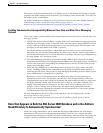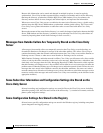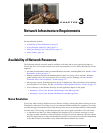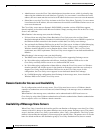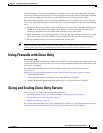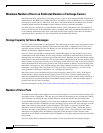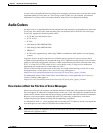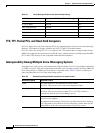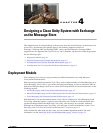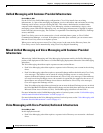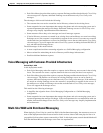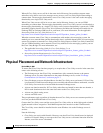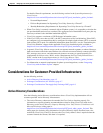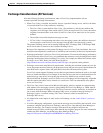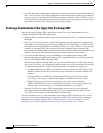
CHAPTER
4-1
Design Guide for Cisco Unity Release 5.x
OL-14619-01
4
Designing a Cisco Unity System with Exchange
as the Message Store
This chapter focuses on using Exchange as the message store and Active Directory as the directory for
Cisco
Unity. All references to Exchange apply to the currently supported versions of
Exchange—Exchange 2007 and Exchange 2003—unless specified otherwise. Exchange 2000 is
supported only for upgrades from Cisco
Unity 4.x and is, therefore, not discussed in this design guide.
See the following topics:
• Deployment Models, page 4-1
• Physical Placement and Network Infrastructure, page 4-4
• Considerations for Customer-Provided Infrastructure, page 4-5
• Considerations for Cisco-Provided, Dedicated Infrastructure, page 4-9
Deployment Models
You can deploy Cisco Unity by using customer-provided infrastructure or by using dedicated,
Cisco-provided infrastructure.
With customer-provided infrastructure, Cisco Unity can be configured either as Unified Messaging or as
Voice Messaging. Cisco
Unity is a part of the messaging environment, it services subscribers who are
homed on existing Exchange e-mail servers, and it uses existing DC/GCs. For more information, see the
following sections:
• Unified Messaging with Customer-Provided Infrastructure, page 4-2
• Mixed Unified Messaging and Voice Messaging with Customer-Provided Infrastructure, page 4-2
• Voice Messaging with Customer-Provided Infrastructure, page 4-3
With dedicated, Cisco-provided infrastructure, Cisco Unity is configured as Voice Messaging. Each
Cisco
Unity subscriber requires a separate Active Directory user account in a dedicated forest and a
separate Exchange mailbox that holds only Cisco
Unity voice messages on a separate, dedicated
Exchange server that homes only Cisco
Unity voice messages. For more information, see the “Voice
Messaging with Cisco-Provided, Dedicated Infrastructure” section on page 4-2.
If the customer has more than one data center, you can combine deployment models. For more
information, see the
“Multi-Site WAN with Distributed Messaging” section on page 4-3.



